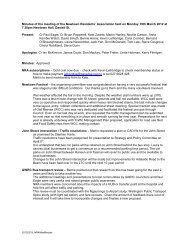Draft Town Belt Management Plan - Wellington City Council
Draft Town Belt Management Plan - Wellington City Council
Draft Town Belt Management Plan - Wellington City Council
You also want an ePaper? Increase the reach of your titles
YUMPU automatically turns print PDFs into web optimized ePapers that Google loves.
left to lie fallow. The garden areas of Taranaki Whānui –Omaroro, Tinakore, Orangi-kaupapa,<br />
which were to become parts of the <strong>Town</strong> <strong>Belt</strong> – were used in these ways often well after the <strong>Town</strong> of<br />
<strong>Wellington</strong> was surveyed in 1840. Much of the forest was maintained as habitat for birds such as<br />
kaka, kereru and others, which were hunted for food.<br />
The other great ridgeline to frame <strong>Wellington</strong> <strong>City</strong> was known as Ahumairangi and later as<br />
Tinakori Hill. Ahumairangi was to feature more in later Māori history as a place where Te<br />
Atiawa/Taranaki Whānui were to establish gardens to feed the pā below and to keep lookouts to<br />
warn of the approach of raiding parties from other tribes. The name Ahumairangi could have<br />
derived from a type of whirlwind. That ridgeline was less favoured for building pā and none were<br />
known to be located there. By the time of Te Atiawa/Taranaki Whānui there had been the change<br />
from fortified pā situated on defendable headlands to pā with minimal fortifications sited around<br />
the harbour and close to the foreshore.<br />
Not all the areas included in the <strong>Town</strong> <strong>Belt</strong> were occupied by Māori with pā and kainga, but the<br />
entire area would have been used for food gathering and bird-snaring. This is acknowledged in<br />
names such as Paekaka, which probably referred to the tree perch for catching parrots and was the<br />
name of a village situated in Thorndon close to the <strong>Town</strong> <strong>Belt</strong>.<br />
Charles Heaphy, speaking in 1879 to the <strong>Wellington</strong> Philosophical Society, recalled that when he<br />
had arrived 40 years earlier, Tinakori Hill was ‘densely timbered ... the rata being conspicuous’.<br />
<strong>Wellington</strong> Terrace was timbered with ‘high manuka some 40ft high’ 49 . Hinau also grew in the area<br />
and its berries were used in bread and rongoa/medicines, as well as being used in ta moko/<br />
tattooing.<br />
Moe-i-te-ra was a Te Atiawa village and cultivations in the vicinity of Central Park and the northfacing<br />
slopes above the park and extending to the Prince of Wales Park. The area is drained by the<br />
Waimapihi Stream, which flowed to the harbour just west of Te Aro Pā.<br />
Puke Ahu/Mt Cook is a low rise between more dominant ridgelines. Te Ranga a Hiwi extended<br />
from Point Jerningham (Orua-kai-kuru) up to Te Matairangi/Mt Victoria and along though Mt<br />
Alfred, near Te Akatarewa Pā, to the old Te Uruhau Pā above Island Bay. The other dominant<br />
ridgeline extended from Ahumairangi/Thorndon Hill through to Te Kopahou, extending out to<br />
Rimurapa/Sinclair Head, along with the Tawatawa Ridge between Island Bay and Owhiro Bay. The<br />
<strong>Town</strong> <strong>Belt</strong> runs close to Puke Ahu near the Prince of Wales Park. Although this part of the <strong>Town</strong><br />
<strong>Belt</strong> does not have high concentrations of Māori cultural sites it would have been well used by<br />
Māori.<br />
The establishment of a ‘green belt’ around the <strong>Town</strong> of <strong>Wellington</strong> came with arrival, in September<br />
1839, of the New Zealand Company and its principal agent Colonel William Wakefield. That year<br />
the New Zealand Company surveyor was instructed that the outside of the inland <strong>Town</strong> should be<br />
separated from the country sections by a broad belt of land, which the company intended to be<br />
public property.<br />
In 1841 Hobson proclaimed the <strong>Town</strong> <strong>Belt</strong> a Crown Reserve. That status existed until 1861 when<br />
the <strong>Town</strong> <strong>Belt</strong> was granted to the provincial superintendent of <strong>Wellington</strong>. In 1873, the<br />
superintendent granted the <strong>Town</strong> <strong>Belt</strong> to the <strong>City</strong> of <strong>Wellington</strong> as a reserve for public recreation.<br />
Hobson also assumed Crown ownership of the islands of Mātiu and Makāro in the early 1840s.<br />
In 1847 Colonel McCleverty recommended that additional land in the <strong>Town</strong> <strong>Belt</strong> should be<br />
assigned to Māori and 219 acres of ‘<strong>Town</strong> <strong>Belt</strong>’ land were assigned to Te Aro, Pipitea and Kumutoto<br />
Māori.<br />
The Waitangi Tribunal 50 concluded the following:<br />
49 Heaphy , C. 1879 Notes on Port Nicholson and the Natives in 1839. Transactions and Proceedings of the New Zealand<br />
Institute XII.<br />
50 Waitangi Tribunal, Te Whanganui a Tara me ona Takiwa, <strong>Wellington</strong> District Report, 2003, p 105<br />
194<br />
<strong>Draft</strong> <strong>Town</strong> <strong>Belt</strong> <strong>Management</strong> <strong>Plan</strong> October 2012





